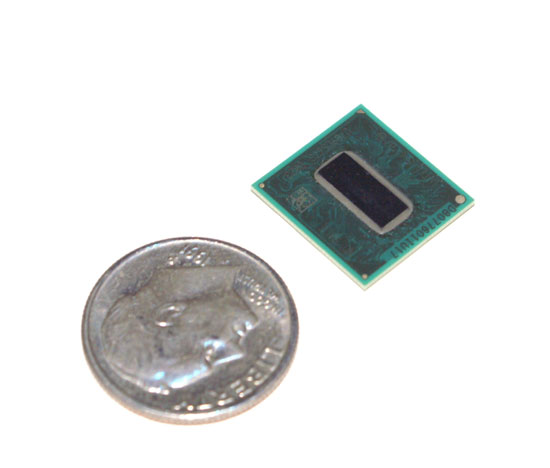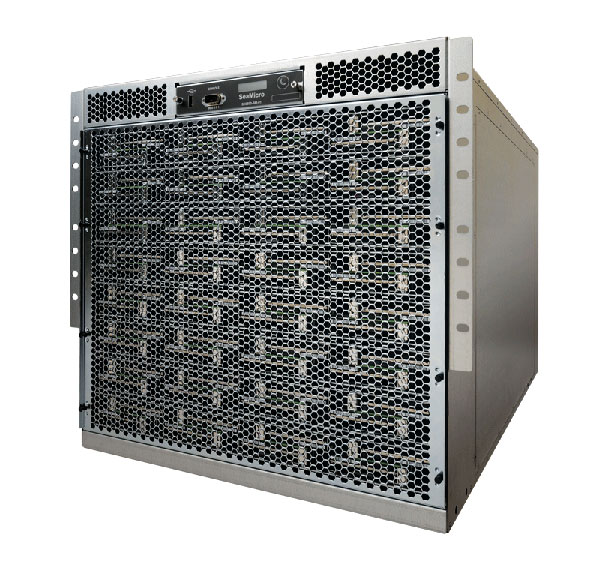SeaMicro Announces SM10000 Server with 512 Atom CPUs and Low Power Consumption
by Anand Lal Shimpi on June 14, 2010 1:38 PM EST- Posted in
- IT Computing
- CPUs
- SeaMicro
Two years ago when I first covered Intel’s Atom architecture I proposed that Moore’s Law has paved the way for two things: 1) ridiculously fast microprocessors, and 2) fast enough microprocessors.
The first category is used to push the bleeding edge of software. Everything from scientific computation to 3D gaming. If it’d never been done before, Moore’s Law enabled companies like AMD, Intel and NVIDIA to build the microprocessors we needed to make it happen.
The second category is a more recent development. If you don’t need the compute power, Moore’s Law enabled the creation of smaller, cheaper, more power efficient microprocessors to deliver performance that’s good enough. These types of chips are found in everything from netbooks to smartphones.

Intel's Atom (Silverthorne) Processor
A number of folks are arguing that the same approach can be applied to server workloads. They argue that the majority of time the servers that drive your favorite websites or cloud services are idle, at least from the CPU perspective. For servers that aren’t virtualized, this is largely true. You don’t build servers for average load, you build them to make sure they can withstand maximum load. The unfortunate result is that when these servers are running during periods of low traffic, they aren’t very power efficient.
For a small operation like AnandTech this isn’t much of a problem. But on a larger scale, it adds up. Data centers are easily power constrained. High density servers give us dozens of microprocessor cores in the space of several rack units. That’s great for compute, but terrible for power consumption.
Also keep in mind that even the slowest servers you can buy today are still pretty powerful. In many cases you need physical box redundancy but not the added horsepower of having more hardware. Add in live fail-over support to minimize downtime and you’ve got even more wasted power.
Today if you don’t need the performance a multi-core Xeon can offer you, but you need tons of physical servers, there are very few options. You can stick with a simple single core server but then your power consumption even at idle is still in the range of dozens of watts. You could make the argument that as CPUs get more powerful, there’s room for a category of “fast enough” servers. And thankfully we already have a processor that’s “fast enough”. The Atom.
Take 512 Atom based servers, cram them into a box that consumes 2kW of power, give it boatloads of networking and you’ve got the SM10000 by SeaMicro. This $139K box is designed to replace dozens of quad core Xeon/Opteron boxes that remain idle most of the time. According to SeaMicro if your business model is that you’re giving something away for free on the Internet, then the SM10000 might be for you.

SeaMicro’s CEO comes from the network field, while its CTO is a former Sun and AMD microprocessor architect (he was apparently one of five chief architects on AMD’s Bulldozer core). The company not only makes the 512 Atom server but also a custom ASIC inside that makes the technology work.

The SM philosophy is simple; you don’t take a space shuttle to the grocery store. If you don’t need such a beefy server for your workload, why continue to use one?










53 Comments
View All Comments
Samus - Wednesday, June 16, 2010 - link
Windows servers account for over half the corporate server market. The rest of the market is filled with a clusterfuck of strange shit like Mac servers, Linux servers running probably close to a dozen different ISA's and then you've got Sun and some other niche' products.This is ALREADY a niche' product. Why would you further convolute the market segment by making a niche' product a niche' product. They're doing the right thing making it compatible with the MAJORITY. An ARM (or niche') product can come if and when this thing successfully makes money.
bmullan - Monday, July 19, 2010 - link
I've been using the ARM based Marvel electronic's $99 "Sheeva" Plug Computers for over a year now. I get mine from GlobalScale.They come with linux (ubuntu) preinstalled but you can install other linux flavors.
I pulled and installed dozens of applications down to those little 4.5 W computers and they all worked fine.
I had several so some were running apache web server apps, some were setup as SAMBA servers for sharing music, videos within my home etc. I'm sure there are problems I've just not encountered but as I said they worked great.
ARMs don't have math co-processing so there are some things they can't do or do well.
But those little $99 Plug computers work great.
I just ordered a couple new models that while still 4.5 Watts, now support -
Linux Kernel 2.6.32
Wi-Fi 802.11b/g
Bluetooth: 2.1 / EDR
U-SNAP I/O
DDR2 800MHz, 16-bit bus
512MB 16bit DDR2 @ 800MHz data rate
NAND FLASH Controller, 8-bit bus
512MB NAND FLASH: 4Gb x8, direct boot
128-bit eFuse Memory
7x GPIOs for user application- 5 with 3.3V I/O, 2 with 1.8V I/O
1x eSATA 2.0 port -3Gbps SATAII
2x USB 2.0
1x Internal MicroSD Socket for Optional Kernel System
1x External MicroSD Socket
RTC w/Battery
Optional with SPI Flash + SD card boot up
UBIFS Flash file system support
NAND Flash boot up
esata
RagingDragon - Tuesday, August 24, 2010 - link
Some ARM implementations have hardware floating point and/or SIMD units, others don't.Those plug computers look interesting, though I haven't dug into hardware specs to see if they have hardware floating point and/or SIMD.
Thog - Tuesday, June 15, 2010 - link
ECC would be nice for a server, but depending on what you're doing, flops are nowhere near as important as concurrency. I'd rather have a box that can run Solaris or Linux i386 out-of-the-box, including applications already compiled for it.nafhan - Wednesday, June 16, 2010 - link
Using Atom instead of ARM makes this almost a drop in replacement for the Xeon/Opteron boxes they are talking about replacing. Once you switch away from x86 you're talking about a lot more work and a lot more risk for enterprise customers to adopt this. An enterprise customer will appreciate the decreased risk the ability to fall back to his old hardware allows. Changing the software stack makes switching back and forth much more difficult.surt - Monday, June 14, 2010 - link
Arm doesn't run x86 workloads very well, does it?loknar28 - Monday, June 14, 2010 - link
They could always make a server version of Windows Mobile, lol.piroroadkill - Tuesday, June 15, 2010 - link
But we're talking server workloads. A server of this scale is probably running Linux and anything you could compile for ARM anyway.Shining Arcanine - Tuesday, June 15, 2010 - link
Exactly what is a x86 workload?GeorgeH - Monday, June 14, 2010 - link
It was inevitable that the first Borg Cube's hive mind would be x86 compliant.Resistance is futile, people.